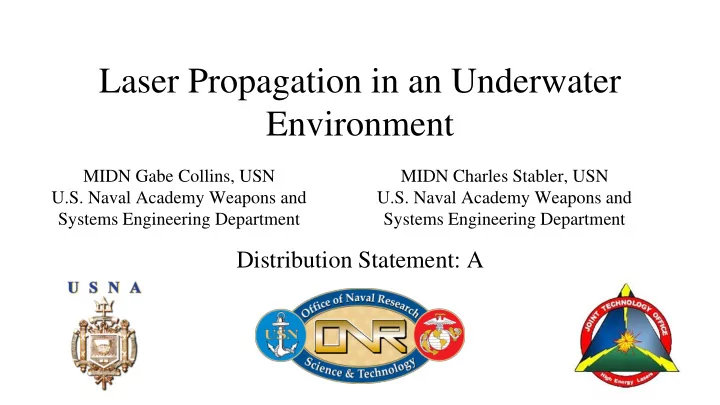

Laser Propagation in an Underwater Environment MIDN Gabe Collins, USN MIDN Charles Stabler, USN U.S. Naval Academy Weapons and U.S. Naval Academy Weapons and Systems Engineering Department Systems Engineering Department Distribution Statement: A
Motivation Detection of: ➔ Optical Wireless Communication Beams Image from SA Photonics Distribution Statement A
Project Objective To study different types of laser beams propagating and scattering underwater to find an optimal method of detection. Distribution Statement A
The Scenarios • Scenario 1: Calm Water • Scenario 2: Turbulent Water created with 12V pump Values Measured • Mean Intensity • Scintillation Index
Spatial Light Modulation • SPATIALLY - beamlets created from incident beam and differ in size • PARTIALLY COHERENT - beamlets differ in phase • MULTI - “flat top” formed of multiple beamlets • GAUSSIAN - shape of beamlets • SHELL - temporal changes • BEAM – reconstruction of beam from beamlets Image from Meadowlark Optics Distribution Statement A
The Beams Beam Type Beam Number 2 mW HeNe Source Unexpanded 1 • Unexpanded Expanded 2 • 10x Expanded Less Coherent 3 • Less Spatially Coherent More Coherent 4 • More Spatially Coherent Distribution Statement A
Equipment Setup Distribution Statement A
Mean Intensity Comparison, Scattering View, of Gaussian and Spatial Modulated Beams in Calm and Turbulent Water Distribution Statement A
Scattering of the Beams in Calm Water Distribution Statement A
Distribution Statement A
Distribution Statement A
Scintillation Index for Propagation in Calm Water Distribution Statement A
Summary of Results in Calm Water Beam Type Beam Number Scattering: Unexpanded 1 Intensity useful for detection of Beams 1 and Expanded 2 2 Less Coherent 3 Scintillation index useful for detection of More Coherent 4 Beams 3 and 4 Propagation: Intensity useful for detection of Beams 1 and 2 Scintillation index useful for detection of Beams 3 and 4 Distribution Statement A
Scattering of the Beams in Turbulent Water Distribution Statement A
Scintillation Index for Propagation in Turbulent Water Distribution Statement A
Summary of Results in Turbulent Water Beam Type Beam Number Scattering: Unexpanded 1 Intensity useful for detection of Beams 1 and 2 Expanded 2 Less Coherent 3 Scintillation index useful for detection of Beams 3 and 4, especially so for Beam 1 More Coherent 4 Propagation: Intensity useful for detection of Beams 1 and 2 Scintillation index useful for detection of Beams 3 and 4 Distribution Statement A
Conclusion SLM Beams - better detected by scintillation calculation Gaussian Beams - better detected by relative intensity measurement Lessons Learned... Distribution Statement A
Acknowledgements Joe Bradshaw, Technical Support Division Norm Tyson, Technical Support Division Nick Eagle, Technical Support Division
Recommend
More recommend